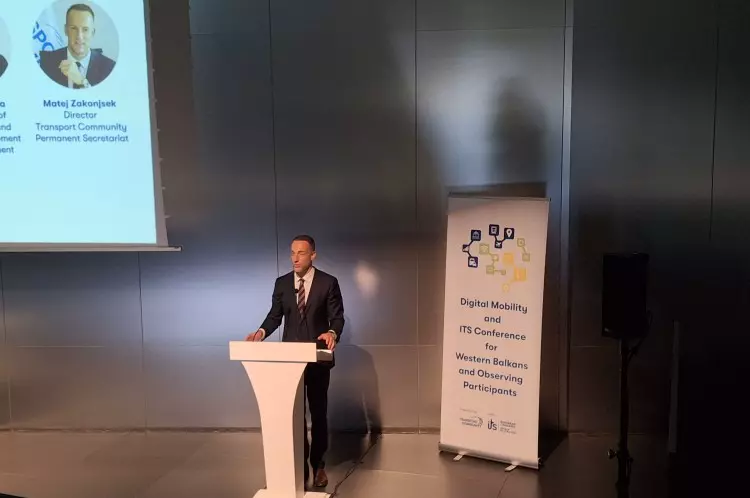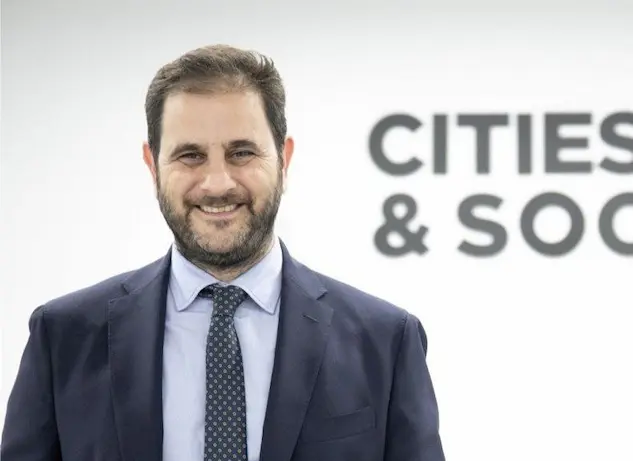As Director of the Transport Community, Matej Zakonjšek draws on years of experience in both European institutions and international business to support the Western Balkans’ integration into the EU transport network. With a background in diplomacy and hands-on involvement in EU transport initiatives, he now focuses on turning cross-border collaboration into practical improvements. In this interview, he talks about the region’s potential for smarter transport for the Western Balkans — and why better connectivity is essential for economic growth, everyday life, and long-term European integration.
A personal journey into transport and regional cooperation
You’ve had a fascinating career. What made you choose a career in transport, and what motivates you to continue working in this field?
For me, transport has always been about connecting people, not just places. From the very beginning of my career, I was fascinated by how roads, railways, ports, and airports can build opportunities for entire communities, create jobs, and improve quality of life. I have always believed that transport is a foundation for a functioning, prosperous society. If you cannot move people or goods, you cannot grow.
What motivates me to keep working in this field is that every day, I see how practical solutions can make lives better, whether it is a new railway modernisation project that shortens travel times or harmonising cross-border controls to help businesses trade more easily. The impact is tangible and lasting, and that is deeply rewarding. I also value the human dimension of transport: working with diverse partners and stakeholders, solving problems together, and ultimately building trust across borders.
In one or two sentences: What is the core mission of the Transport Community, and what makes it different from other regional transport initiatives?
The Transport Community’s mission is to integrate the Western Balkans transport systems with the European Union through the adoption of EU legislation, standards, and best practices, while promoting safe, sustainable, and efficient mobility. Unlike other initiatives, we are founded on a legally binding Treaty, which means we have long-term stability and a joint decision-making structure that truly empowers the regional partners to own their progress, with the EU’s full backing.
Why transport integration matters now
Why is connecting the Western Balkans to the EU transport network important at this stage?
The whole region is geographically and economically intertwined with the European Union, and yet many barriers still exist that prevent smooth flows of people and goods. At this stage, with new geopolitical realities, growing trade links, and the EU accession perspective stronger than ever, integrating the region’s transport networks with those of the EU is essential to strengthen resilience, boost competitiveness, and unlock further growth.
It is also a way to strengthen the European family as a whole. Transport connectivity is a practical symbol of European solidarity. When railways cross borders seamlessly and trucks don’t have to wait hours at border crossings, it shows people what European integration means in their daily lives. That is why this effort is so important right now.
Finally, enhancing connectivity is about linking the region to the EU, and about positioning South East Europe as a vital bridge to the wider continent and beyond. By improving transport links along the shortest land routes to the Middle East and Central Asia, the Western Balkans can become a true gateway for trade and mobility between Europe and these growing markets.
Are the Western Balkans in a position to leap forward with smart mobility and digital infrastructure, or is there still a major gap to close?
I would say there is a strong appetite in the region to leap forward, and the foundation exists: increasing adoption of modern technologies, and political support for smarter mobility. But there is also a sizeable investment and capacity gap to close, particularly when it comes to digital traffic management systems, data-sharing frameworks, and cross-border interoperability.
The region can definitely leapfrog by building on lessons from EU Member States and avoiding costly mistakes. Still, to make smart mobility a reality, we must prioritise funding and maintenance, skills development, and a supportive regulatory environment, working together with industry, universities, and the public sector.
For example, with the introduction of modern, interoperable tolling systems, some Western Balkan regional partners implementing tolls for the first time have the opportunity to adopt the latest technologies from the outset. This allows them to leap directly to state-of-the-art solutions, avoiding legacy systems and setting a strong foundation for smart mobility in the region.
Building smarter transport for the Western Balkans
Can you share one or two success stories in recent EU-backed infrastructure projects in the region?
Firstly, the key example is the implementation of the Green Lanes initiative at key intra-regional border crossings. Thanks to coordination between the Transport Community, CEFTA, regional governments, and EU institutions, we managed to significantly reduce waiting times for freight during the COVID-19 pandemic, which kept supply chains functioning and demonstrated what is possible with collaboration. This model is now being extended to the key border crossings between the region and the EU, and we aim to reduce waiting times for up to 70% in the next couple of years.
Another tangible example is the opening of the joint rail border crossing at Bijelo Polje. By working together, Montenegro and Serbia, with EU support, have created a border crossing that enables seamless rail traffic, eliminating unnecessary delays and inspections. This will mean faster, simpler journeys for passengers, and more efficient transport for goods. Harmonised procedures and interoperable systems here are setting an example of how we can build a more integrated, connected, and competitive Western Balkans, aligned with the European standards.
Finally, what we are looking for is the modernisation of the Belgrade–Niš rail section in Serbia, which is part of the Corridor X, a flagship corridor that links Greece with Central Europe. With EU funding, this project aims at rehabilitating the railway section, enabling a high-speed rail connection of up to 200 km/h. Once completed, this project will cut travel times, improve safety, and dramatically increase capacity for freight transport. This will be truly transformative for people and businesses from across Serbia and beyond.
What are the main challenges delaying implementation of major transport projects?
There are a few recurring challenges. First, administrative bottlenecks such as lengthy permitting, complex tendering procedures, and fragmented responsibilities, which often delay projects even after financing is secured. Second, institutional capacity in parts of the region is still developing, which means managing large-scale projects takes longer and sometimes lacks continuity.
Finally, coordination between different national authorities, and sometimes even between ministries within a regional partner, can slow down critical decisions. Our role at the Transport Community is to help overcome these barriers through technical support, regional coordination, and sharing of best practices.
What are the top priorities for improving rail infrastructure in the Western Balkans, and how realistic is a modal shift from road to rail?
The absolute priority is modernising the core rail corridors: upgrading track infrastructure, modernising stations, improving safety systems, and introducing European Railway Traffic Management System (ERTMS) for interoperability. Rolling stock also needs investment so trains can be faster, more comfortable, and more reliable.
A modal shift from road to rail is realistic in the medium term if we make rail a credible alternative. That means opening the markets, upgrading infrastructure, and improving timetables, ensuring predictable and fair pricing, as well as reforming the sector to encourage more efficient rail operators. Customers, both passengers and freight, will switch to rail if it is genuinely competitive in terms of speed, reliability, and cost. We have an example as a proof: since the opening of modernised Belgrade–Novi Sad railway line, millions of people were using it.

Cross-border flow, urban mobility, and strategic alignment
What are the key obstacles to smoother cross-border transport in the region, and how can they be overcome?
The key obstacles are fragmented border procedures, poor coordination between border agencies, and a lack of interoperable digital systems. Trucks and trains often face long waiting times simply because systems do not “talk” to each other or inspections are duplicated.
The solution lies in harmonising customs and sanitary controls, establishing One-Stop Border Crossing facilities, and fully deploying digital systems that allow real-time data exchange. The Transport Community is actively supporting regional partners to coordinate investments and modernise procedures, because the benefits such as shorter waiting times, lower costs, and greater predictability, are enormous.
How can the region manage growing interest from non-EU actors while staying aligned with EU transport and sustainability goals?
The region is of strategic interest to many global players, and investment is welcome, but it has to be transparent and consistent with the rules and standards laid down in the Transport Community Treaty which are, in their essence, the EU rules.
To stay on track, governments must demand open, competitive procurement processes, insist on applying EU standards in construction and operation, and ensure projects fit into long-term sustainable mobility strategies.
In other words, the key is to be open to partnerships but also to safeguard the European perspective through rigorous technical standards, transparent financing, and policy coherence.
What can be done to better support clean and accessible public transport in Western Balkan cities?
Urban mobility is critical because that is where most people experience transport every day. We need to invest much more in modern, low-emission buses, and trams, with secure and comfortable stops and stations. But infrastructure alone is not enough. Cities need to adopt sustainable urban mobility plans that put walking, cycling, and public transport at the centre while discouraging private car use in congested cores.
Affordability is also crucial, because a sustainable transport system should serve everyone, not just higher-income groups. That is why targeted subsidies, smart ticketing, and social pricing policies are just as important as the infrastructure.
Looking ahead: digital tools, vision, and new generations
What key takeaways from the ITS European Congress in Seville 2025 could help advance smarter, more integrated transport in the region?
One clear takeaway is that smart transport systems must work across modes, borders, and authorities to deliver their full value. Standards, interoperability, and public-private collaboration are key.
Secondly, user-centric solutions like Mobility-as-a-Service, integrated ticketing, and real-time travel data can transform how people move if deployed on a regional scale and made accessible to everyone. These are already working in parts of Europe, and the Western Balkans can adopt and adapt them rapidly with the right partnerships.
What would you personally like to see in terms of transport in the Western Balkans 10 years from now?
Our vision is a seamlessly connected Western Balkans, with modern rail corridors fully integrated into the EU transport network, border crossings that are no longer bottlenecks but rather gateways, and urban areas where walking, cycling, and zero-emission public transport are the first choices for citizens.
I would also like to see a mature, professional transport sector in the region with empowered experts, fair opportunities for young people, and a real sense of pride in delivering sustainable, safe, and efficient mobility for all. That is the legacy I hope we can collectively build over the next decade.
What advice would you give to young professionals in the region who want to work on improving transport systems?
I would say: do not think of transport as just “infrastructure.” Think of it as an ecosystem where technology, engineering, public policy, economics, and human behaviour all come together. Develop curiosity about all these aspects. Also, invest in your ability to communicate and build partnerships, because transport projects succeed only with teamwork and trust. Finally, believe in the power of change. The region needs fresh energy and new perspectives, and you can be the one to bring them. If you stay passionate and open to learning, you can make an extraordinary contribution.


